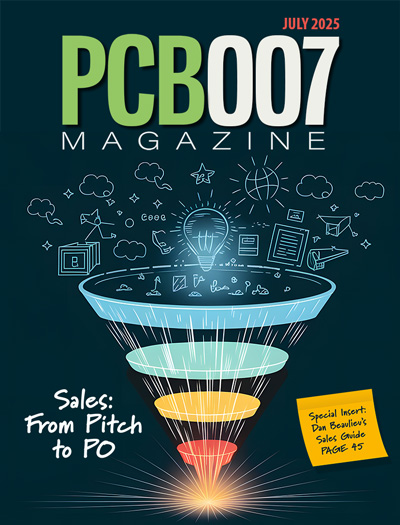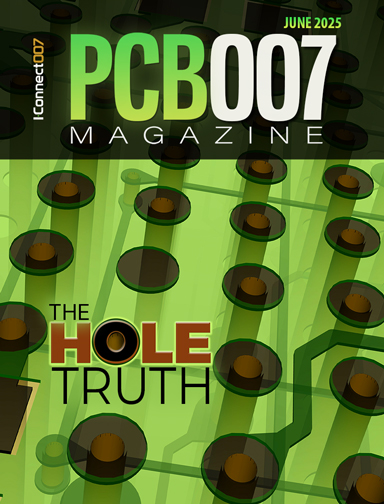-

- News
- Books
Featured Books
- pcb007 Magazine
Latest Issues
Current Issue
Inventing the Future with SEL
Two years after launching its state-of-the-art PCB facility, SEL shares lessons in vision, execution, and innovation, plus insights from industry icons and technology leaders shaping the future of PCB fabrication.

Sales: From Pitch to PO
From the first cold call to finally receiving that first purchase order, the July PCB007 Magazine breaks down some critical parts of the sales stack. To up your sales game, read on!

The Hole Truth: Via Integrity in an HDI World
From the drilled hole to registration across multiple sequential lamination cycles, to the quality of your copper plating, via reliability in an HDI world is becoming an ever-greater challenge. This month we look at “The Hole Truth,” from creating the “perfect” via to how you can assure via quality and reliability, the first time, every time.
- Articles
- Columns
- Links
- Media kit
||| MENU - pcb007 Magazine
Substrates for Advanced PCB Technologies: What Will the Future Hold?
November 6, 2018 | Pete Starkey, I-Connect007Estimated reading time: 9 minutes
Francey used the example of a beam-switching Rotman Lens antenna to illustrate typical millimetre-wave PCB structures and discussed the defining features and critical tolerances that had to be satisfied within the PCB manufacturing technology. To summarise, he quoted the words of a microwave engineer: “When the frequency increases, everything has got to shrink. Manufacturing tolerances start to become a problem at about 20-30 GHz. Below that, you can pretty much design anything you want; the production will not fail. Above that, it is no exaggeration to say that everything is about manufacturing tolerances and producibility. Being a microwave designer is a completely different job at 77 GHz compared to one GHz.”
In his concluding comments, Francey observed that the laminate industry was meeting the needs for system miniaturisation, signal integrity, assembly, and reliability with thinner cores and engineered polymer composites to satisfy dielectric and thermomechanical requirements. Moreover, the PCB industry was reacting to the needs for higher packaging densities, signal integrity, and the use of PCB technology in IC packaging. However, he stressed that the convergence of future needs for circuit miniaturisation, feature tolerances, and feature-to-feature positional could only be achieved with additive technology, which would require a step change in PCB manufacturing capability and know-how.
I found this webinar enlightening and extremely interesting. I learned a lot from it, and I am grateful to IMAPS-UK for giving me the opportunity to attend. Piers Tremlett and Jim Francey should be congratulated for the quality and content of their presentations and thanked for generously sharing their knowledge and experience. Thanks also to Martin Wickham for acting as the anchorman, and to the ubiquitous Bob Willis for his professional management of the event.
Page 3 of 3Testimonial
"The I-Connect007 team is outstanding—kind, responsive, and a true marketing partner. Their design team created fresh, eye-catching ads, and their editorial support polished our content to let our brand shine. Thank you all! "
Sweeney Ng - CEE PCBSuggested Items
Closing the Loop on PCB Etching Waste
09/09/2025 | Shawn Stone, IECAs the PCB industry continues its push toward greener, more cost-efficient operations, Sigma Engineering’s Mecer System offers a comprehensive solution to two of the industry’s most persistent pain points: etchant consumption and rinse water waste. Designed as a modular, fully automated platform, the Mecer System regenerates spent copper etchants—both alkaline and acidic—and simultaneously recycles rinse water, transforming a traditionally linear chemical process into a closed-loop system.
Driving Innovation: Depth Routing Processes—Achieving Unparalleled Precision in Complex PCBs
09/08/2025 | Kurt Palmer -- Column: Driving InnovationIn PCB manufacturing, the demand for increasingly complex and miniaturized designs continually pushes the boundaries of traditional fabrication methods, including depth routing. Success in these applications demands not only on robust machinery but also sophisticated control functions. PCB manufacturers rely on advanced machine features and process methodologies to meet their precise depth routing goals. Here, I’ll explore some crucial functions that empower manufacturers to master complex depth routing challenges.
Trouble in Your Tank: Minimizing Small-via Defects for High-reliability PCBs
08/27/2025 | Michael Carano -- Column: Trouble in Your TankTo quote the comedian Stephen Wright, “If at first you don’t succeed, then skydiving is not for you.” That can be the battle cry when you find that only small-diameter vias are exhibiting voids. Why are small holes more prone to voids than larger vias when processed through electroless copper? There are several reasons.
The Government Circuit: Navigating New Trade Headwinds and New Partnerships
08/25/2025 | Chris Mitchell -- Column: The Government CircuitAs global trade winds continue to howl, the electronics manufacturing industry finds itself at a critical juncture. After months of warnings, the U.S. Government has implemented a broad array of tariff increases, with fresh duties hitting copper-based products, semiconductors, and imports from many nations. On the positive side, tentative trade agreements with Europe, China, Japan, and other nations are providing at least some clarity and counterbalance.
How Good Design Enables Sustainable PCBs
08/21/2025 | Gerry Partida, Summit InterconnectSustainability has become a key focus for PCB companies seeking to reduce waste, conserve energy, and optimize resources. While many discussions on sustainability center around materials or energy-efficient processes, PCB design is an often overlooked factor that lies at the heart of manufacturing. Good design practices, especially those based on established IPC standards, play a central role in enabling sustainable PCB production. By ensuring designs are manufacturable and reliable, engineers can significantly reduce the environmental impact of their products.


